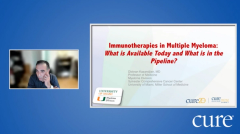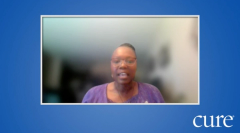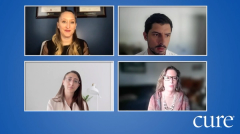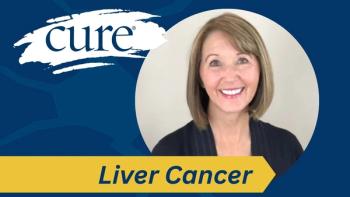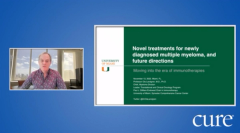
Educated Patient® Multiple Myeloma Summit Disease Overview Panel: November 13, 2022
Watch Dr. C. Ola Landgren and Dr. David Coffey answer questions about novel treatments and the role of a healthy immune system during the CURE® Educated Patient® Multiple Myeloma Summit.
This panel was moderated by Kristie L. Kahl, and included Dr. C. Ola Landgren, from Sylvester Comprehensive Cancer Center, University of Miami, and Dr. David Coffey, from Sylvester Comprehensive Cancer Center, University of Miami Health System.
Kahl: So I know we're going to be talking about MRD later in the day, but to set that in motion and explain what it is, Dr. Landgren we had a couple of questions come in. So I'm just going to combine them and just address what exactly is MRD negativity and how does one know if they're MRD negative?
Landgren: Also excellent questions, Kristie, thank you for addressing those. So what is MRD negativity? So it refers to the use of a sensitive type of test, we call it an assay in the lab, that is performed by a certain protocol. And after the results have been generated, if you cannot find any leftover disease cells, you can say that this individual is now MRD negative. It is usually done after completion of combination therapy. For patients who undergo transplant, it is usually done after that as well. And by guidelines, you can also be repeated, say on an annual basis for an individual who is on maintenance therapy.
There are definitions for what MRD negativity is, you cannot just develop your own local test in the laboratory. That used to be the case, but that's no longer okay. So you have to be able to rule out one myeloma cell in 100,000 tested cells. And you can not only test 100,000 cells, you have to test many hundreds or thousands, actually millions of cells. So you have to do a good job, you have to do certain markers in that assay. And if you read that out, you say this individual is MRD negative.
I'd like to say a couple of more details and say that there are newer tests that are available that can rule out one cell in the million. And there is emerging data showing that if you have 100 people treated at MRD negative, one cell in 100,000. And then you investigate these 100 people with these newer tests that can do one cell in a million. Let's say half of these patients are MRD negative, one cell in a million, they're deeper negativity. If you plot out the progression-free follow up time, the ones that are negative with a more sensitive assay have a longer progression-free survival. So that tells us that we have more sensitive technologies, we are able to identify people that have a better projected outcome.
I think the field is probably going to go in that direction. And lastly, I want to say that there are also new assays in development with blood-based MRD testing, that is also going to happen and I think we will see this probably in the coming one to five years, it's gradually going to happen. We are working here in Miami with protein assays, we are also working on circulating cells, and circulating DNA in the blood. In 2023, we will start opening up the platform where we will offer any patient who comes here as part of our standard-of-care testing with blood-based MRD testing. This will probably happen many places, I'm sure.
Kahl: Great. Thank you. And Dr. Coffey, I'm going to combine these two. So directing towards antibodies, does this mean that kappas and lambdas are good antibodies? And a second follow up: Can multiple antibodies be given at once?
Coffey: Super good question. So let's talk about kappa and lambda first. If you can imagine in your mind a Y-shaped molecule, which is the antibody, the top part of the Y, or the kappa and the lambda light chains, and then the inner part and bottom part Are they heavy chain, the IgG for example. And so the antibody can be measured and it's intact, both for the IgG. Or we can just measure the kappa and lambda. Kappa and lambda is normally made in every person and detection of some of it is good. It's when one sees an imbalance in the ratio, more kappa than lambda by a significant amount or more lambda than kappa by a significant amount. That's when we say that there's probably a myeloma style making excess amount of one type of light chain, which is an indicator that the disease is still present. So that's how we use the cap on the lambda measurements to assess if there is still disease.
And the next question that was asked is can we give multiple antibodies and I'm thinking what you're talking about is the monoclonal antibodies such as (Darzalex [daratumumab]) or (Empliciti [elotuzumab]). At this juncture we are only giving one antibody at a time. We're not combining the (drugs). It's not to say that it's a bad idea. And maybe it's something that we could try in the future. But we generally focus on attacking the myeloma cell using one cell surface protein molecule at a time. So I'm not aware of any studies (evaluating) multiple antibodies in the same treatment.
Landgren: Well, if we're talking about combinations of antibodies for the treatment of myeloma, there are already trials in development using bi-specific with naked antibodies, specifically, (Tecvayli [teclistamab]) with daratumumab or (Tarceva [erlotinib]). And I think there will be many, many more to come. Clinicaltrials.gov has the complete list. I foresee that the field will have antibody combinations for most lines, including newly diagnosed first line and probably also for relapsed disease, that will be my prediction and probably in combinations with both immunomodulatory drugs such as (Revlimid [lenalidomide]), but also there are immune activating antibodies, such as CD28, and others where you can activate the immune system and then link the immune effector cells to the myeloma cells, I think we will see much more CAR T cells with antibodies or NK cells with antibodies. It just started to begin. What do you think, David?
Coffey: Absolutely. Like I said, it's a great idea. Sometimes myeloma cells will lose their cell surface protein. So if you're putting all your eggs in one basket and hoping the myeloma still has the BCMA on its surface, you may lose out. But if you put in a second antibody, then you're increasing the chances that you're going to be able to attack it.
Kahl: And so, we had a question come in Dr. Landgren. If we can control myeloma, if for example, with like daratumumab, pomalidomide and then dexamethasone long term, can you rock the boat and eliminate one of these drugs to maybe even avoid side effects or make it less toxic?
Landgren: So if you have a combination, as you mentioned here, say with daratumumab with pomalidomide and dexamethasone, if you look and see in the clinical databases…I think you will see that the vast majority of patients eventually will have some form of dose reductions. And you can also go and look online for published papers. I mentioned my study where you had daratumumab, lenalidomide and dexamethasone, if you go online and look up in the New England Journal of Medicine, there is something called the supplement online, that means that all the details that they didn't put in the paper are actually available online, anyone can download it. I like to read the supplements, because that's usually (where) all the important details have been put. And I found that the amount of lenalidomide that was given to patients on the MAIA study was in the range of 60% or 70%, of what they initially had planned. So that tells me that out of 10 patients, maybe three or four of them actually did not continue with lenalidomide. There are too many long-term as the only maintenance drug. Or alternatively, many patients go the lower dose, they may be gone just half the dose. And that is exactly what we see in our clinical databases. The patients over time start cutting back, some patients stopped the daratumumab, some patients stopped the lenolidomide. Some patients do have the dose of the immune for tolerability, and we don't really know what the ultimate strategy is in terms of improving outcome. Probably the disease is so different across patients. So some patients can have a very good outcome we must last treatment, I would think. So we probably overtreat some patients. So what we don't want to do is obviously to handle treat. So that's why we need to, again, integrate MRD testing with profiling of the individual patient’s disease. For precision medicine, we need to be better at tailoring the treatments for individual patients.
Kahl: Absolutely. And Dr. Coffey, can you speak to the importance of the GI tract to the immune system? And in particular, are there any foods that could potentially enhance the immune system?
Coffey: That’s a super good question. There's a lot of active research doing exactly that, trying to understand what are the good bacteria in our immune in our gut They're important for a healthy immune system. We call that the microbiome. And just within the past few years, we've developed better technologies that allows us to take a single sample of stool, for example, and look to see all the different kinds of bacteria live in that sample. And we've been able to associate specific species of bacteria with certain outcomes in cancer, not just in multiple myeloma. So the question is, are there specific foods that we can eat that could potentially enhance our immune system? Well, I don't think that we've got the answer quite yet. I think that the jury's still out on that. And I can't name a specific food that I would recommend over another that would introduce new bacteria. But I certainly think the idea of using a probiotic, if you are not neutropenic, might be a good way to introduce healthy bacteria into the GI tract that is so important to a strong immune system.
Kahl: Absolutely. And Dr. Landgren, we had a question. So you talked about progression-free survival on a few of the trials that you presented. So if we're getting, let's say, 21 months of progression-free survival, and ideally that would allow for other treatments to still be available in later lines (of therapy). Would these additional treatments increase overall survival? Can you maybe explain how that progression-free and overall survival work with the multiple lines of therapy.
Landgren: So these are very technical details. So when we talk about overall survival, that means that we want to have all the patients being alive. We talk about progression-free survival, that means that patients are alive and they don't have any recurring blood protein, monoclonal protein or light chains in the blood. So we know when we have a newly diagnosed patient that we follow this individual over time, we check labs in my clinic, I usually check labs every three months, if I use maintenance therapy, which I do for most of my patients. When I see that there is a rise in the marker, I would in the vast majority of cases be that doctor finding that there is a recurrence. The patient would say I feel great. And many times, we check again in a month, and the patient would tell me I feel great. And it could just stay like this for a very long time.
So when we talk about progression-free survival, we are talking about the returning protein. So when you talk about the studies, I mentioned that 21-month longer progression-free survival by all show there is no difference in overall survival. What this specifically means is that there could be reoccurrence of these proteins in the blood. And eventually you would change the treatment. And when you change the treatment in the vast majority of cases, these proteins will go away again.
But the field has really changed. I've been a doctor for more than 25 years, I've treated many patients with myeloma, I remember a long time ago, the patient was sick when they had relapse, the patient had a lot of symptoms. These days, we have so many technologies. So it's usually the doctor that identifies the recurring disease and the patient feels great. Also, back in the day, we only had a few drugs to choose between. But today we have so many. So the correlation between progression-free survival and overall survival, as I showed on the slides, is just not there. I think you can see in many of the trials, why you still see correlations, most of those trials have done in other parts of the world where there are no other treatment options. So if a patient has a relapse, there may only be one or two more treatment options. And then they run out of options, which is not how it is in the United States. So I think that the future will be in my opinion, that we will have to have biomarkers for drug development. I think MRD will be the future biomarker for drug development. If you can show higher rates of MRD negativity, I think drugs in the future will be approved based on that. That will be my guesstimate. And I also think that it will be correlated with longer progression-free survival. And studies done here in the US. I think in the future, we'll have problems showing overall survival differences, because there are so many good treatments available. So you can just offer new therapy all the time, which is a good thing.
Transcription edited for clarity.
For more news on cancer updates, research and education, don’t forget to



